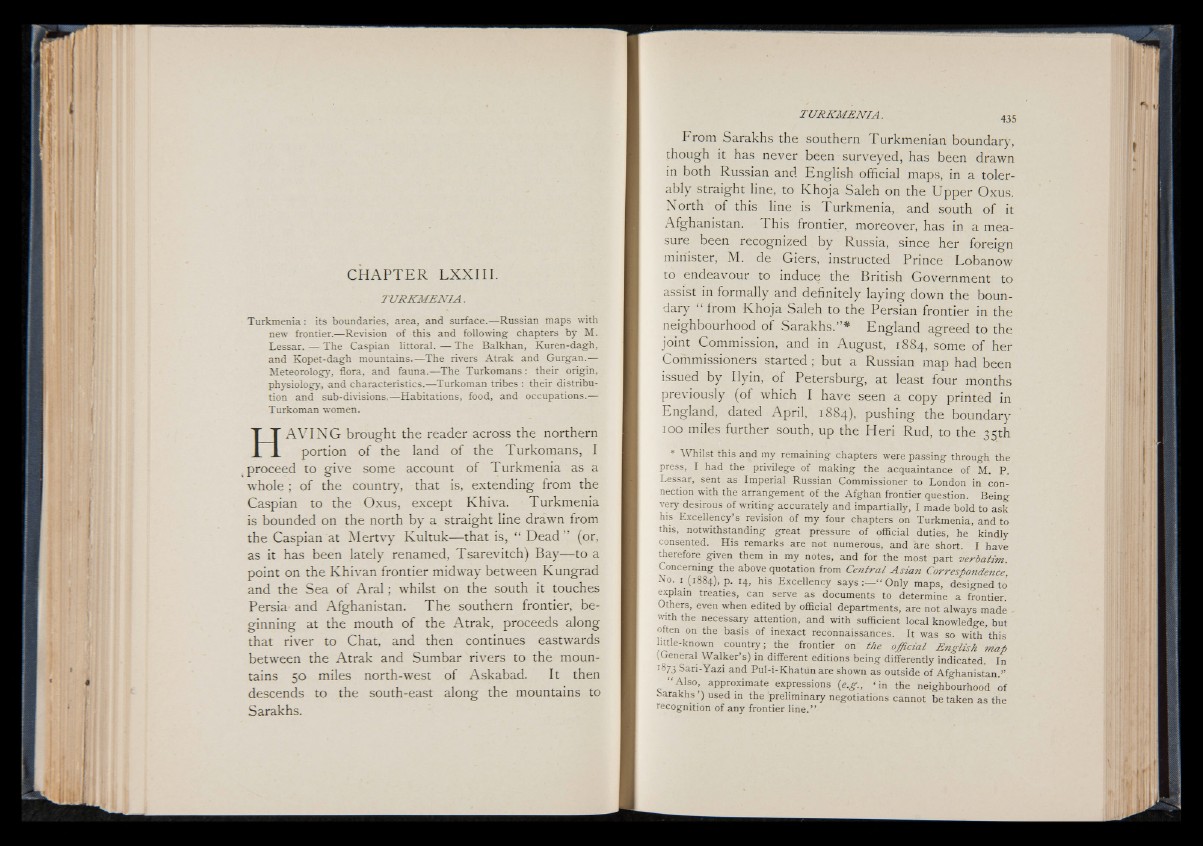
C H A P T E R L X X I I I .
TURKMENIA.
Turkmenia: its boundaries, area, and surface.— Russian maps with
new frontier.— Revision of this and following chapters by M.
Lessar^— The Caspian littoral.— The Balkhan, Kuren-dagh,
and Kopet-dagh mountains.— The rivers Atrak and Gurgan.—
Meteorology, flora, and fauna.—The Turkomans: their origin,
physiology, and characteristics.—Turkoman tribes : their distribution
and sub-divisions.— Habitations, food, and occupations.—
Turkoman women.
HA V IN G brought the reader across the northern
portion of the land of the Turkomans, I
proceed to give some account o f Turkmenia as a
whole ; of the country, that is, extending from the
Caspian to the Oxus, except Khiva. Turkmenia
is bounded on the north by a straight line drawn from
the Caspian at Mertvy Kultuk— that is, “ Dead ” (or,
as it has been lately renamed, Tsarevitch) Bay— to a
point on the Khivan frontier midway between Kungrad
and the Sea o f A r a l; whilst on the south it touches
Persia and Afghanistan. T he southern frontier, beginning
at the mouth o f the Atrak, proceeds along
that river to Chat, and then continues eastwards
between the Atrak and Sumbar rivers to the mountains
50 miles north-west o f Askabad. It then
descends to the south-east along the mountains to
Sarakhs.
From Sarakhs the southern T urkmenian boundary,
though it has never been surveyed, has been drawn
in both Russian and English official maps, in a tolerably
straight line, to Khoja Saleh on the Upper Oxus.
North of this line is Turkmenia, and south of it
Afghanistan. This frontier, moreover, has in a measure
been recognized by Russia, since her foreign
minister, M. de Giers, instructed Prince Lobanow
to endeavour to induce the British Government to
assist in formally and definitely laying down the boundary
“ from Khoja Saleh to the Persian frontier in the
neighbourhood of Sarakhs.” * England agreed to the
joint Commission, and in August, 1884, some of her
Commissioners started; but a Russian map had been
issued by Ilyin, of Petersburg, at least four months
previously (of which I have seen a copy printed in
England, dated April, 1884), pushing the boundary
100 miles further south, up the Heri Rud, to the 35th
* Whilst this and my remaining chapters were passing through the
press, I had the privilege of making the acquaintance of M. P.
Lessar, sent as Imperial Russian Commissioner to London in connection
with the arrangement of the Afghan frontier question. Being
very desirous of writing accurately and impartially, I made bold to ask
his Excellency s revision of my four chapters on Turkmenia, and to
this, notwithstanding great pressure of oflicial duties, he kindly
consented. His remarks are not numerous, and are short. I have
therefore given them in my notes, and for the most part verbatim.
Concerning the above quotation from Central Asian Correspondence,
No. 1 (1884), p. 14, his Excellency says Only maps, designed to'
explain treaties, can serve as documents to determine a frontier.
Others, even when edited by official departments, are not always made
with the necessary attention, and with sufficient local knowledge, but
often on the basis of inexact reconnaissances. It was so with this
little-known country; the frontier on the official English map
(General Walker’s) in different editions being differently indicated. In
1873 Sari-Yazi and Pul-i-Khatun are shown as outside of Afghanistan.”
“ Also, approximate expressions (e.g., ‘ in the neighbourhood of
oarakhs’) used in the preliminary negotiations cannot betaken as the
recognition of any frontier line.”